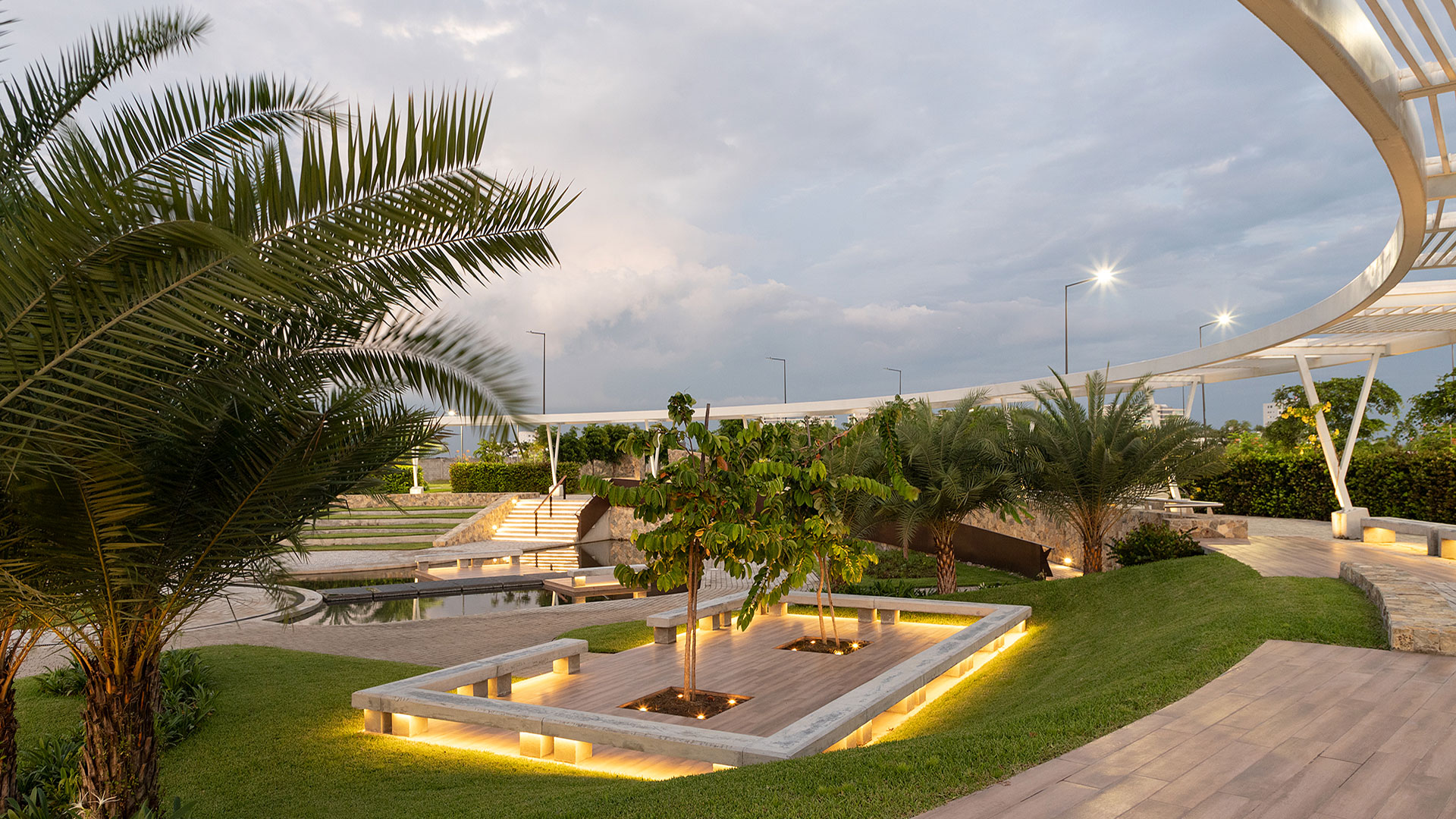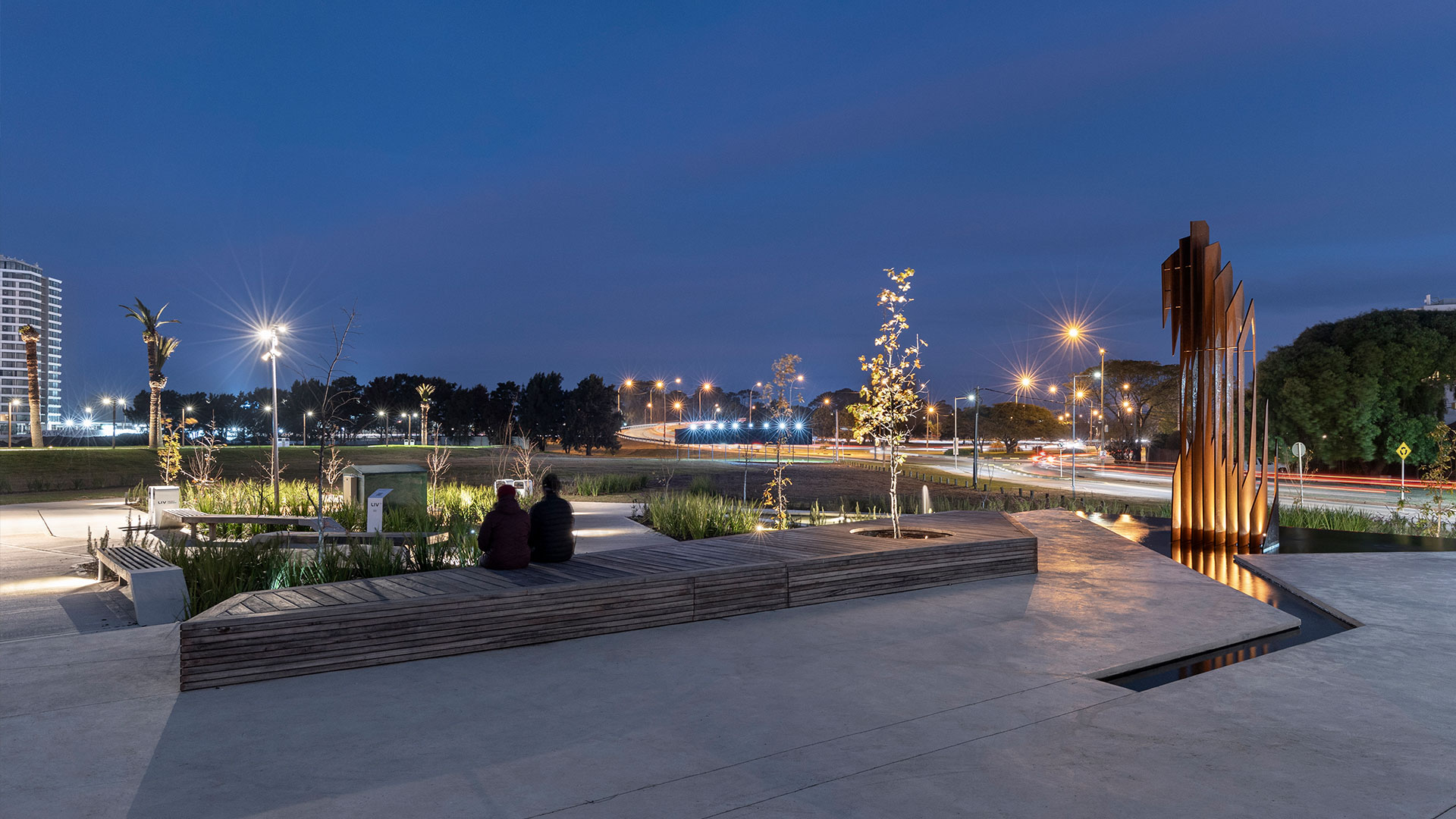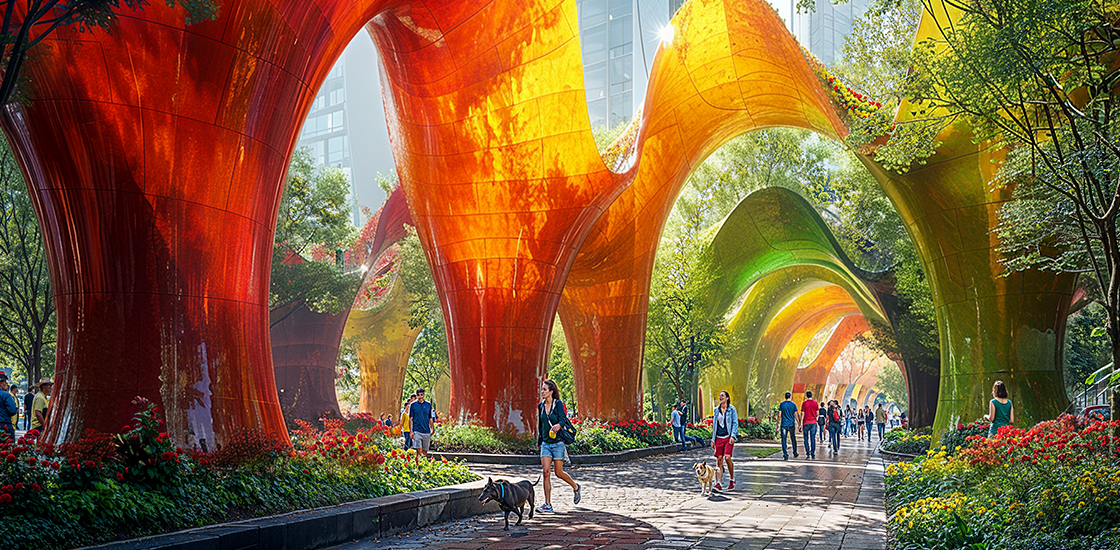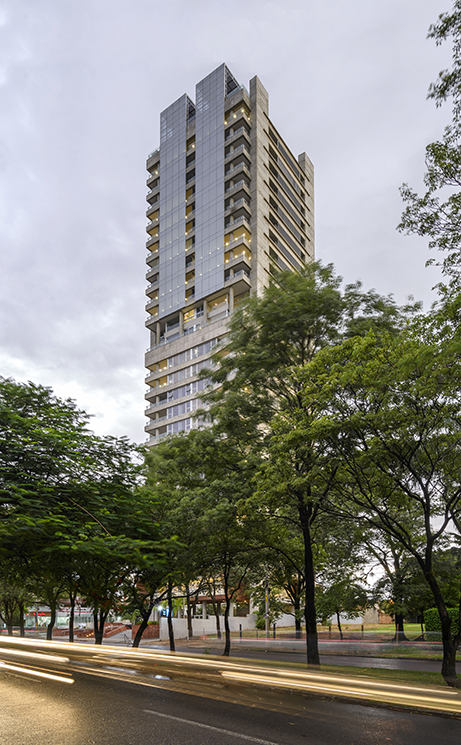

Contemporary landscape architecture has evolved into the design of immersive experiences. More than simply organizing nature, it seeks to choreograph the relationship between body, territory, and culture—transforming every space into a sensory and communal narrative.
Reading time: 7 minutes
Gardens, Plazas, and Parks: Living Systems of Meaning
Gardens, plazas, and parks are no longer just green spaces; they are living systems of meaning that shape the identity of cities and the well-being of their inhabitants. In this new paradigm, landscape is no longer a backdrop but becomes the protagonist. Every texture, scent, and sound is part of a narrative that appeals to collective memory.
Environmental design thus becomes a tool for urban culture, reconnecting people with their territory and transforming the everyday experience of public space.
Landscape architecture has undergone a remarkable transformation in recent decades, adapting to the needs of contemporary cities. Today’s urbanists are moving beyond the rigid grids and inhospitable spaces of the twentieth century, embracing local materials, native vegetation, and a sensitive reading of place. The goal is to create environments that blend public and private, ecological and symbolic, adding value and meaning to residential, commercial, and civic settings.
Norwegian architect and theorist Christian Norberg-Schulz, a central figure in the phenomenology of space, argued that every project must capture the genius loci—the spirit of place that gives meaning to architectural experience. In contemporary landscape architecture, this pursuit translates into a space’s ability to tell its own story. It is at this intersection of the natural and the built where design reveals its deepest power: shaping a sense of belonging.
A study published in Landscape and Urban Planning found that urban parks integrating historical and cultural elements increase residents’ sense of belonging and collective memory by 30%. This demonstrates how landscape architecture can preserve a city’s historical and cultural continuity, strengthening local identity.

The Memory of Place
Every landscape holds geographic, ecological, and social memory. Designing with this awareness means reading the site before intervening—understanding its rhythms and materiality. Rather than imposing an aesthetic, it’s about letting the site speak.
Brazilian architect and artist Roberto Burle Marx, a pioneer of modern landscape architecture in Latin America, was among the first to understand the garden as a cultural expression. His compositions, based on native tropical species, celebrated Brazilian identity and fused art, botany, and modernity.
Decades later, Chilean landscape architect Teresa Moller continues this spirit with a contemporary poetics. In works like Bahía Azul, the coastal landscape becomes an experience: paths blend into the terrain and visitors merge with the geography. Her interventions are minimal, but their emotional impact is immense.
British-American urbanist James Corner, a leading figure in landscape urbanism, described landscape as a palimpsest—a surface where each intervention writes a new layer of meaning without erasing the previous ones. In this patient layering, landscape architecture becomes a narrative of time and memory.
In the Río de la Plata region, the landscape project for El Nido in José Ignacio explores the local ecosystem—composed of grasses, native shrubs, wind- and salt-resistant bushes, and some introduced species like eucalyptus and pine—as a visual language of identity. The aim is not to impose a new landscape, but to reveal the one that already exists, building a narrative that is both ecological and cultural.
Public Space: Nature as Infrastructure
Urban expansion has shown that cities cannot be conceived solely in terms of density or mobility; quality of life depends, among other factors, on access to nature. Parks, plazas, waterfronts, and green corridors are now essential infrastructure, both for environmental balance and social cohesion.
The use of native vegetation and materials in urban design significantly contributes to creating a sense of place. According to a study in the Journal of Environmental Psychology, the use of local flora increases residents’ identification with their environment by 25%, strengthening their emotional and cognitive connection to the city.
Far from being a luxury, urban green infrastructure is a vital necessity. Access to green spaces reduces stress, improves mental health, and lowers the incidence of cardiovascular disease by 15–20%, according to the World Health Organization. Parks not only promote social interaction and physical activity, but also strengthen community cohesion.
Projects like the High Line in New York—designed by Diller Scofidio + Renfro in collaboration with James Corner Field Operations and Piet Oudolf—or the Parque de la Memoria in Buenos Aires, by Estudio Baudizzone-Lestard-Varas together with Claudio Ferrari and Daniel Becker Arquitectos, demonstrate how green spaces can transform the relationship between city, art, and memory. In Uruguay, projects like the renewal of Parque Roosevelt are moving in this direction. The restoration of wetlands, revitalization of the lake, transformation of the arena, installation of a giant event dome, and creation of new recreational and sports areas not only regenerate ecosystems and promote active mobility, but also consolidate a local identity that integrates nature and culture.
A comparative study published in Cities concluded that cities investing in landscape architecture adapted to their topography and native vegetation exhibit a stronger and more recognizable urban identity, both for residents and visitors.
At its best, urban landscape architecture democratizes the aesthetic experience: it transforms everyday space into a place for gathering, contemplation, and belonging.

Geography as Cultural Signifier
Contemporary landscape architecture increasingly assumes an identity-building and symbolic role within the city. It’s not just about beautification, but about constructing shared cultural references that serve as landmarks, memory anchors, and sources of collective belonging. Landscape becomes an urban language capable of distilling the spirit of a place and projecting it to its community, enhancing quality of life.
In urbanism, geography—relief, topography, vegetation, relationship to water or the horizon—forms the deepest substrate of identity. No other element so permanently defines a city’s character. Incorporating this geographic dimension into public space design means recognizing that territory is also a cultural construct, a matrix of meaning upon which urban life is inscribed.
Identity-driven landscape architecture seeks to translate this territorial matrix into form, movement, and experience. In doing so, it turns geography into symbol: landscape ceases to be merely tamed nature and becomes an urban and narrative sign. Thus, a park, promenade, or waterfront can function as a landscape landmark—a visible expression of a community’s memory and identity.
Projects like Parque Bicentenario in Santiago de Chile, Millennium Park in Chicago, or the Rambla of Montevideo show how landscape can act as an urban emblem. Unlike architectural icons, landscape does not impose an object; it proposes a collective experience. Its symbolic power lies in everyday life—in how the community inhabits, traverses, and reinterprets it over time.
This perspective aligns with the notion of “landscape as cultural structure,” developed by American theorist Elizabeth Meyer, who argues that landscape design should construct meaning, not just form. Similarly, James Corner suggests that landscape projects should act as an active reading of the territory, capable of revealing its historical, ecological, and symbolic layers.
A city that recognizes its landscape and transforms it into an active part of public space not only improves its livability, but also reaffirms its cultural character and historical continuity. In this context, landscape is much more than vegetation or infrastructure: it is the material expression of a community and its geography.
Identity, Sustainability, and Experience
Today, the boundaries between landscape architecture, architecture, and urbanism are increasingly blurred. These disciplines engage in a shared pursuit: designing holistic experiences that reflect both cultural sensitivity and environmental responsibility.
Projects such as Casa Meztitla by Mexican firm Ambrosi Etchegaray or the MACA Museum in Uruguay, led by sculptor Pablo Atchugarry, show how materiality, light, and landscape merge to create atmospheres that transcend form.
These examples point toward a new design ethic—one that understands sustainability not only in ecological terms, but also in cultural and emotional dimensions.
Landscape is, above all, a visible form of identity. Every park, promenade, or urban edge is the contemporary imprint of a geography that recognizes itself. That is why designing landscape is projecting a form of culture: a way of inhabiting territory, interpreting it, and transforming it without erasing its memory.
In times of aesthetic globalization, the true contemporary gesture is not to replicate international models, but to reinterpret the territory from within, understanding that every city has a landscape that narrates its story. When design draws on this uniqueness—its relief, vegetation, climate, and history—the result is not just a green space, but a collective experience of belonging.
Thus, landscape architecture asserts itself as a project of urban identity, capable of articulating sustainability, memory, and community. Its power lies in this dual condition: being ecological infrastructure and, at the same time, a cultural narrative.
Because inhabiting, after all, is not just about occupying a space, but about recognizing oneself in it.




